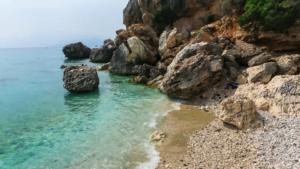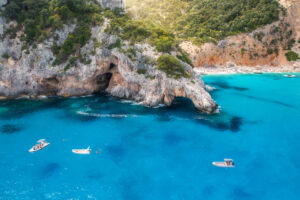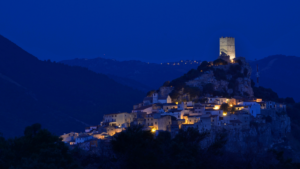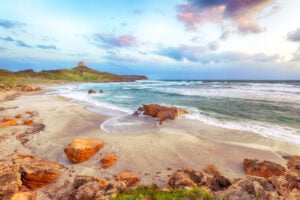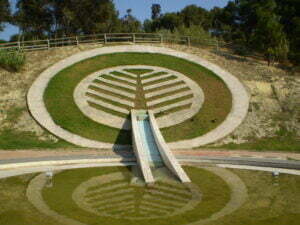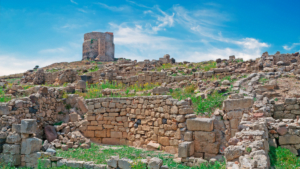Sardinian is the language of Sardinia. It is considered as one of the languages that is closest to latin.
What You Will learn about the Language Of Sardinia
Explore the captivating world of the Sardinian language in this article, where you’ll discover:
- The Diversity of Dialects: Unravel the variety of Sardinian dialects spread across the island, each with its own unique identity and history.
- Linguistic Roots and Distinctions: Dive into Sardinian’s Latin origins and see how it sets itself apart from Italian and other Romance languages.
- Historical Influences: Learn about the external influences that have shaped Sardinian over centuries, from Spanish to Arabic and Byzantine impacts.
- Current Status and Revitalization Efforts: Understand the challenges Sardinian faces today and the efforts being made to keep this rich language alive through education, media, and cultural initiatives.
- Cultural Significance: Appreciate the deep cultural significance of Sardinian in maintaining and expressing the unique identity of Sardinia’s people.
Get ready to explore the essence and enduring spirit of Sardinia through its language.
Sardinian Dialects and Their Distribution
The Sardinian language, with its rich history and cultural significance, boasts several dialects that highlight the island’s linguistic diversity. These dialects, while sharing a common root, present unique characteristics and are distributed across different regions of Sardinia. Understanding these dialects and their distribution offers insight into the island’s complex linguistic landscape.
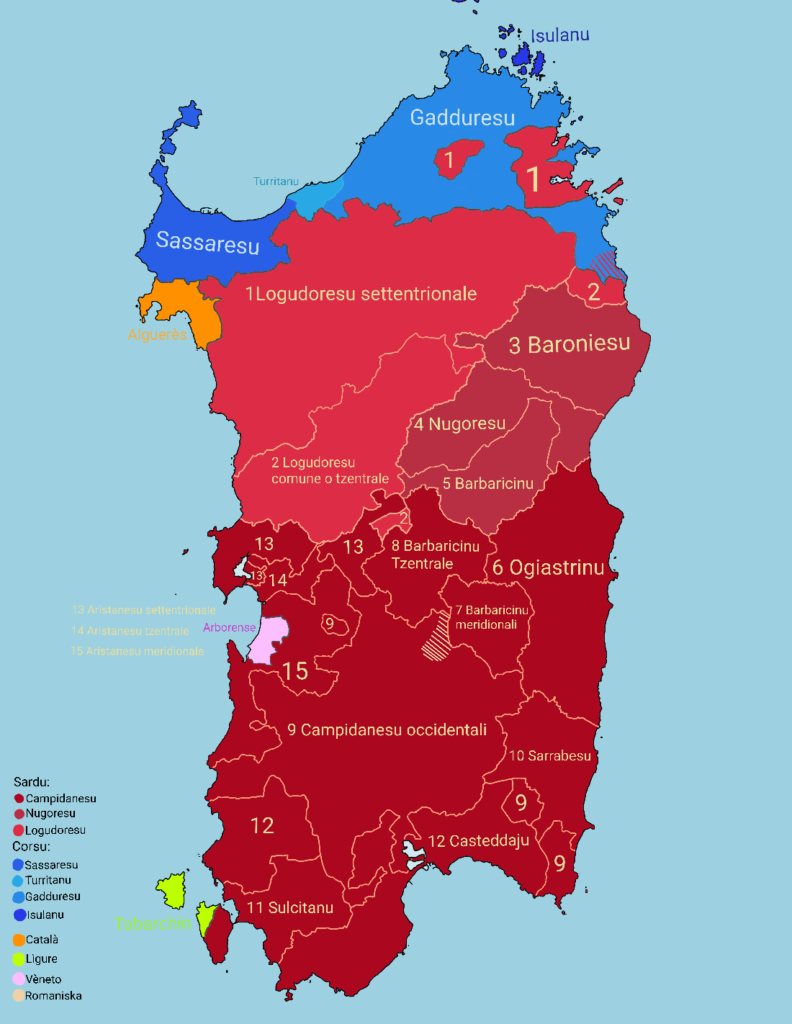

The Four Main Dialects
- Campidanese (Campidanesu)
- Geographical Distribution: This dialect is mainly found in the southern regions of Sardinia, particularly around the Campidano plain, from which it gets its name. The capital city of Cagliari also features this dialect.
- Linguistic Characteristics: Campidanese is noted for its distinct phonological features and vocabulary that distinguish it from its northern counterpart. It has been influenced by various historical rulers of Sardinia, including the Spanish, which is evident in its lexicon.
- Logudorese (Logudoresu)
- Geographical Distribution: Predominantly spoken in the central and northern parts of Sardinia, the Logudorese dialect extends from the central-northern region down to the southern parts of the island, encapsulating a wide linguistic area.
- Linguistic Characteristics: Considered by many as one of the most conservative dialects of Sardinian, Logudorese retains many elements close to Latin. It is characterized by its conservative phonetics and lexicon, making it a focal point for linguistic studies on Romance languages.
- Sassarese (Sassaresu)
- Geographical Distribution: Sassarese is primarily spoken in the northwest corner of Sardinia, especially around the city of Sassari. Its distribution includes a few other towns in the proximity of Sassari.
- Linguistic Characteristics: This dialect represents a transitional linguistic phenomenon, showing features of both Corsican and Sardinian. Its vocabulary and phonetics are influenced by the Corsican language due to the historical connections between Sardinia and Corsica.
- Gallurese (Gadduresu)
- Geographical Distribution: Gallurese is found in the northeastern part of Sardinia, particularly in the Gallura region. This dialect extends to some of the most picturesque parts of the island, including the Costa Smeralda.
- Linguistic Characteristics: Similar to Sassarese, Gallurese shows a strong influence from Corsican due to geographical proximity and historical interactions. It is often considered a variant of Corsican rather than Sardinian, although it is part of the linguistic fabric of the island.
The distribution of these dialects across Sardinia reflects the island’s geographical divisions and historical influences. From the conservative, Latin-like sounds of Logudorese to the Corsican influences in Sassarese and Gallurese, and the Spanish-inflected Campidanese, the dialects of Sardinian tell the story of an island at the crossroads of Mediterranean cultures. Understanding these dialects is essential for appreciating the depth of Sardinia’s linguistic heritage and its contribution to the diversity of the Italian language.
Linguistic Characteristics of Sardinian
The Sardinian language, known as “Sardu” in its own lexicon, stands out among the Romance languages for its distinctive characteristics, deeply rooted in its ancient Latin heritage, and shaped by a myriad of historical influences. This linguistic profile makes Sardinian not only a fascinating subject of study but also a vital link to understanding the evolution of languages in the Mediterranean region.
Latin Roots and Distinction from Italian
The origin of ancient Sardinian (Paleo Sardinian) are unknown. There are multiple options and associations: Sheren, Lydia, similarities with Etruscan language and from Lybian mythology.
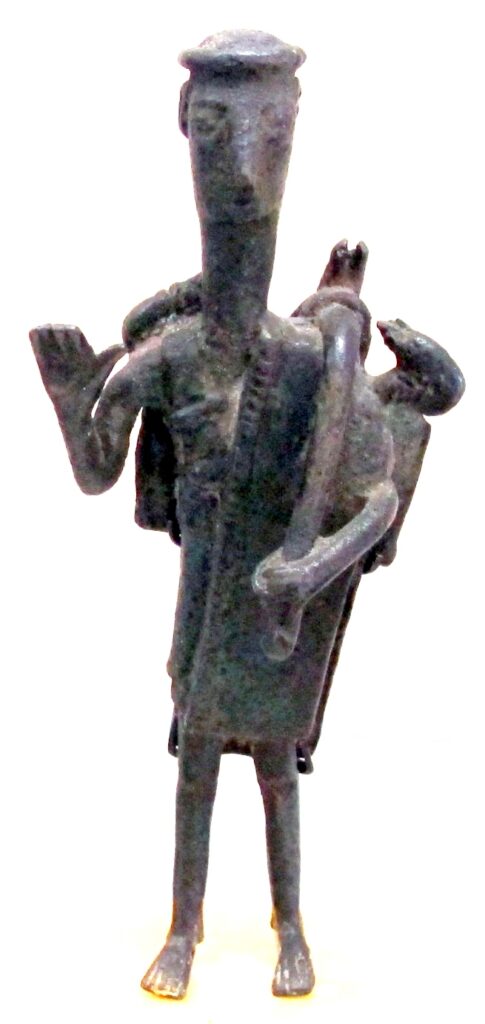

Unlike Italian, which evolved from the vernacular Latin spoken in the Tuscan region and was heavily influenced by the literary works of Dante, Petrarch, and Boccaccio, Sardinian developed somewhat in isolation, preserving many archaic Latin phonetic and lexical elements.
- Phonetic Conservation: Sardinian is renowned for its conservative phonology, retaining many Latin sounds that have disappeared in other Romance languages. For instance, Sardinian preserves the Latin “k” sound in front of “e” and “i” (e.g., “cerbu” for “brain”, compared to Italian “cervello”), and maintains the hard “g” sound where other languages have shifted (e.g., “gelu” for “ice”, compared to Italian “ghiaccio”).
- Lexical Archaism: The vocabulary of Sardinian includes terms that are direct descendants of Latin words, unchanged in meaning. This direct lineage makes Sardinian a vital resource for linguists tracing the evolution of Romance languages.
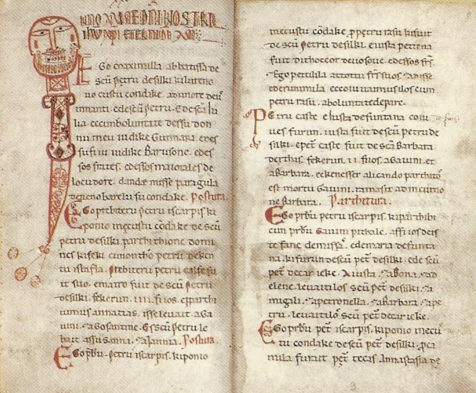

Historical Influences
Over the centuries, Sardinia has been a crossroads of Mediterranean cultures, each leaving a linguistic imprint on the island’s language. These external influences have enriched Sardinian, adding layers of complexity to its already rich base.
- Spanish and Catalan Impact: Due to the long period of Aragonese and Spanish rule, Sardinian absorbed a significant number of loanwords from Spanish and Catalan. This influence is particularly evident in the Campidanese dialect, where words ending in “-o” in Italian and Spanish often end in “-u” in Sardinian, reflecting Spanish phonetic patterns.
- Arabic Influences: Although less pronounced, the Arabic presence in the Mediterranean also left traces in the Sardinian language, mainly through place names and agricultural terms, a legacy of the Moors’ raids and temporary settlements on the island.
- Byzantine Greek Contributions: The Byzantine Empire’s control over Sardinia introduced Greek vocabulary, especially in the realms of religion and administration. These terms often coexist with Latin-based words, offering a unique glimpse into the island’s complex history of governance and cultural exchange.
Sardinian Language Today


The Sardinian language remains a vibrant yet challenged component of Italy’s cultural heritage. Today, the status of Sardinian reflects a complex interplay between tradition and modernity, as the language navigates the pressures of globalization and cultural assimilation.
Current Status and Use
Sardinian is currently recognized as a minority language under Italian law and enjoys a level of protection and promotion as a result. Despite these protections, the number of fluent speakers has been in decline, a trend observed across many regional and minority languages worldwide. Recent estimates suggest that there are between 500,000 to 1 million speakers of Sardinian, with a higher concentration in older generations.
In everyday life, the use of Sardinian varies significantly across the island:
- Rural vs. Urban Areas: The language tends to be more actively spoken and present in rural communities, where traditional lifestyles are more prevalent. In contrast, urban areas, including larger cities like Cagliari, see a more considerable influence of Italian, with Sardinian often reserved for informal settings among family and friends.
- Public Life: Sardinian is less visible in public life and official settings, where Italian dominates. However, there is a growing presence of Sardinian in local media, signage, and cultural events, reflecting efforts to revitalize the language.
Generational Divide in Language Fluency
A significant generational divide exists in the fluency and usage of Sardinian. Older generations often speak Sardinian as their first language and maintain a deep connection to the island’s cultural traditions. Conversely, younger Sardinians typically learn Italian as their first language, with Sardinian fluency varying widely. Many young people understand Sardinian to some extent but may not speak it fluently, a phenomenon known as “passive bilingualism.”
Initiatives to Revitalize Sardinian
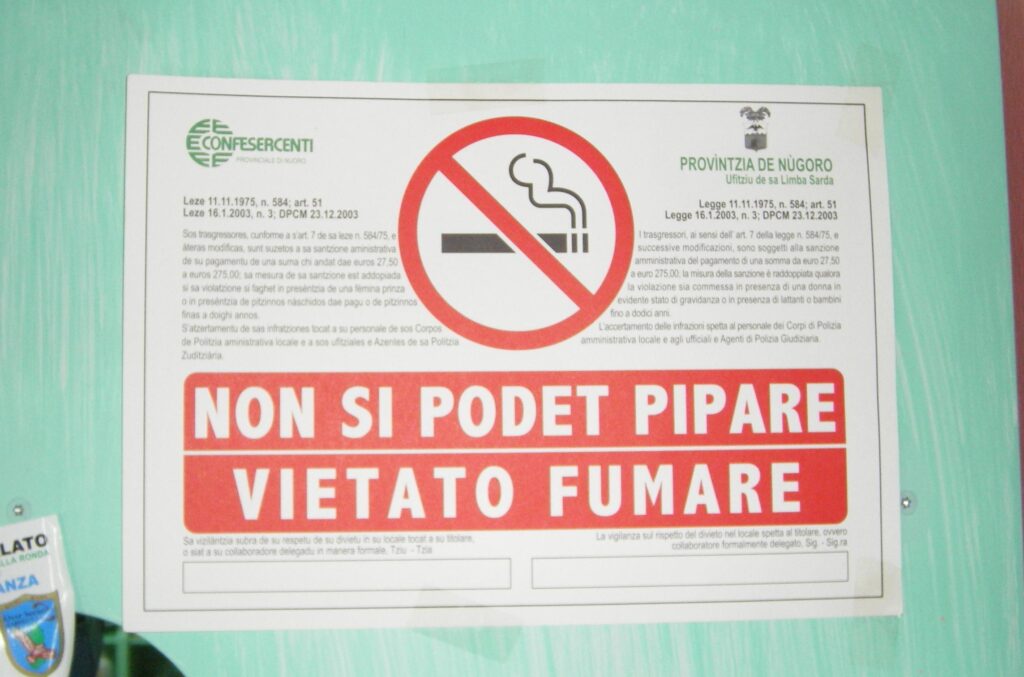

Recognizing the cultural value of Sardinian and the risks posed by its decline, various initiatives have been launched to revitalize the language, particularly among younger generations:
- Education: Efforts are underway to introduce or expand Sardinian language instruction in schools, from elementary through to high school levels. These programs aim to foster bilingualism and cultivate a sense of pride and identity in Sardinian heritage.
- Media and Technology: The use of Sardinian in local media, social media, and digital platforms is increasing. These channels provide a modern context for the language, making it more accessible and relevant to younger audiences.
- Cultural Promotion: Festivals, music, literature, and theater in Sardinian play a crucial role in keeping the language alive. Cultural initiatives often serve as an entry point for young people to engage with their linguistic heritage.
The Sardinian language today stands at a crossroads, balancing between preservation and adaptation. While challenges remain in ensuring its widespread use and transmission to future generations, the concerted efforts of communities, educators, and policymakers offer hope for its revitalization. As a living testament to Sardinia’s rich history and cultural diversity, Sardinian continues to be an essential part of the island’s identity, with ongoing initiatives aiming to secure its place in the modern world.
Challenges of the Sardinian Language
The Sardinian language, with its ancient roots and rich cultural significance, faces several contemporary challenges. These challenges stem from sociolinguistic changes and the global trend towards linguistic homogenization. Yet, in response to these obstacles, a vibrant movement towards the preservation and revitalization of Sardinian has emerged, leveraging education, media, and the arts.
Challenges Facing the Sardinian Language
- Diminishing Fluency Among Younger Generations:
- The trend of diminishing fluency in Sardinian among younger generations is perhaps the most pressing challenge. This phenomenon is largely due to the dominance of Italian in educational systems, media, and public life, leading to a generational shift where Sardinian is not the primary language of communication at home or in the community.
- Competition with Italian:
- Italian, as the official language of Italy, presents significant competition to Sardinian. The widespread use of Italian in professional, academic, and official contexts often relegates Sardinian to a secondary status, affecting its perceived utility and prestige among the island’s inhabitants.
- Globalization and Cultural Homogenization:
- The forces of globalization and the increasing accessibility of global media and entertainment have also contributed to the challenges faced by Sardinian. These influences often prioritize global languages over regional or minority languages, further eroding the linguistic landscape in which Sardinian can flourish.
Cultural Significance of Sardinian
The Sardinian language is not merely a means of communication; it is a cornerstone of Sardinia’s cultural identity, embodying the island’s history, traditions, and values. As such, Sardinian plays a pivotal role in the communal and individual expression of identity, linking the present to a rich past while navigating the challenges and opportunities of the future.
Role in Cultural Identity
- Historical Continuity: Sardinian offers a linguistic window into the island’s past, carrying with it the echoes of ancient civilizations, foreign dominations, and resilient local traditions. Through its words, proverbs, and syntax, the language encapsulates centuries of Sardinian history, making it a living archive of the island’s heritage.
- Expression of Local Identity: In Sardinia, language is a key marker of local identity. Each dialect reflects the unique character of the area it is spoken in, from the rugged highlands to the serene coastlines. This diversity within unity highlights the complexity of Sardinian culture, where local peculiarities are celebrated as part of the broader Sardinian identity.
- Social Bonds: Sardinian facilitates a deep sense of belonging and community among its speakers. It is the language of family gatherings, traditional festivals, and everyday interactions, fostering solidarity and continuity across generations.
Efforts to Promote Sardinian
Given its importance to cultural identity, various efforts are underway to ensure the survival and promotion of the Sardinian language:
- Education Initiatives: There is a growing push for the inclusion of Sardinian in educational curricula at all levels. Schools across the island are increasingly offering courses in Sardinian, aiming to foster bilingual proficiency among students. These educational programs are crucial for equipping younger generations with the linguistic skills necessary to keep the language alive and vibrant. There is also a Wikipedia in Sardinian.
- Media and Digital Presence: Sardinian is finding its voice in the modern digital landscape. Local television and radio stations broadcast in Sardinian, and social media platforms have become a space for the language to thrive. Websites, apps, and online resources are being developed to support learners and speakers, ensuring Sardinian’s relevance in the digital age.
- Cultural Celebrations: Festivals, concerts, literary contests, and theatrical performances in Sardinian play a vital role in promoting the language. These events not only celebrate Sardinian’s linguistic beauty but also educate the public about its importance. By engaging the community in cultural practices rooted in the Sardinian language, these events strengthen the connection between the language and Sardinian identity.
- Legislative Support: The recognition of Sardinian as a minority language has led to policies aimed at its promotion and protection. These legislative efforts support the use of Sardinian in public administration, education, and the media, providing a formal framework for its revitalization.
The ongoing efforts to promote Sardinian through education, media, and cultural events are not just about preserving a language; they are about nurturing a sense of identity, pride, and community among Sardinians. As such, the future of Sardinian is intrinsically tied to the island’s cultural dynamics, with each word spoken acting as a testament to the enduring spirit of Sardinia.



